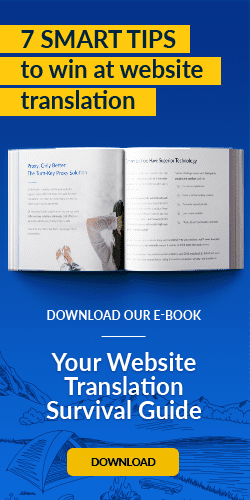For brands seeking to engage new customers and discover previously-untapped revenue streams, there’s no easier or more affordable way than by launching translated websites in global markets.
While translation is a resonant first step towards wooing international consumers, it's not the only step. We recently spoke with Logan Lenz, a Global Online Strategist with our Global Growth team, on the subject. He provided three critical ingredients for brands who are expanding into online overseas markets:
Invest In Parity
Brands engaging new markets-and the Spanish-speaking U.S. Hispanic market in particular-should invest in content parity, Logan says. Based on MotionPoint user experience studies and client customer surveys, we've learned that when the contents of a company's Spanish-language site differ greatly from its primary-market English site, Hispanic shoppers often tune out.
But before they tune out, they feel alienated—which is a major liability for a brand.
To avoid this risk, brands should deliver a comparable primary-market experience to their translated sites, Logan says. But that doesn't mean they can't change some content. "There is a sweet spot when it comes to ensuring that your multilingual websites mirror the primary-market site shoppers have learned to trust," he says.
When brands change more than 20% of their messaging, shoppers fear they’re not receiving the same robust experience.
We've found that during localization, 80% to 90% of a brand's primary-market website should remain untouched from a structural and functionality standpoint. This includes page framework and layout, product assortments, and page hierarchy.
“The other 10 to 20 percent should include necessary changes to promotions, social icons, payment methods and campaign messaging,” Logan says.
We've discovered that when brands change more than 20% of their localized customer-facing messaging, new shoppers may fear they're not receiving the same robust shopping experiences offered by the brand's primary-market site. The disparity can breed mistrust among some consumers.
This became clear several years ago when a MotionPoint retail client changed the default imagery it used for some of its product categories on its Spanish site. The intent was to create Hispanic-friendly content that would resonate with shoppers. A/B tests quickly determined, however, that the approach was more "miss" than "hit."
During localization, 80% to 90% of a brand’s primary-market website should remain untouched from a structural and functionality standpoint.
"Clicks and checkouts decreased when Hispanic shoppers saw the 'customized' product images," Logan says. "Skeptical Hispanic shoppers were toggling back and forth between the Spanish and English versions of the site. They saw this difference in content, and felt alienated. In fact, they said they didn't appreciate the cultural stereotype seen in the Spanish-site images.
"Smartly choosing what to localize and what not to localize is key," Logan continues. "Avoid stereotypes. If you're unsure of messaging, make sure to A/B test it before deploying it site-wide. This prudent approach can provide valuable insights into your audience."
Localize for Relevancy
Logan's next tip zeroes in on that 10% to 20% of content that should be localized, beyond mere translation, for global customers. This kind of unique, market-specific customization should be reflected in banner images (not necessarily product images, as seen above), payment methods, promotions, or user experience.
Time and time again, we’ve seen these localized on-site content campaigns generate powerful and immediate results among customers.
Last year, MotionPoint worked with a telecom client on ways to increase conversions on its U.S. Spanish site. When the client deployed our recommended promotional banner, which prominently featured international calling plans, its visits grew by 850%. Revenue surged 117%. Average order value rose by 43%.
We've also optimized translations for specific markets, to increase their relevance and resonance with local shoppers. This meticulously-minded, culturally-savvy translation approach really works. One fashion retailer saw an 11% lift in conversions after we fine-tuned several on-site phrases. Another telecom company's conversions grew by nearly 20%. A global airline's checkouts grew by about 70%, too.
Ten to twenty percent of content should be localized, beyond mere translation, for global customers.
"It's about building trust," Logan says. "If you make new customers feel like you know what they want, and can communicate in resonant ways, they feel more comfortable with paying you money for your goods."
Optimize for Engagement
Note that this tip isn’t called “Optimize for Conversion,” a key distinction for Logan.
"Conversion equates to sales or actual customer acquisition," he says, "and that's certainly important for the long-term. But during your brand's earliest days in a new market, the more appropriate priority is humanizing your brand, and connecting with the local audience."
Logan cites MotionPoint's recent collaboration with a fashion client, in which the client created unique blog sections for its recently-launched global websites. These market-specific sections highlighted local celebrities and local fashion trends. The end result? A reading experience that is unique to each geographical market. Resonant stuff.
Brands should be where their customers are. In most cases, that means social networks.
"This best practice doesn't stop at these customized site sections," Logan advises. "It's recommended, if you have the resources to do so, to support your market website with a strong social presence."
We recently covered the value of localizing social media posts, but it bears repeating: at its simplest, brands should be where their customers are. In most cases, that means social networks.
Our savvy fashion client embraces this best practices. It shares style tips on the Russian social network VK.com, and aggregates similar relevant materials across networks. Doing this not only confirms that there are people at the company who legitimately enjoy talking about fashion, Logan says, but it also positions these employees as subject matter experts in the area.
"Ultimately, show them you're serious about serving their market," Logan says of global customers. "Garner their feedback when necessary. Absorb cultural learnings and be agile. This will lead to more trust-and more sales."
Last updated on March 22, 2016
